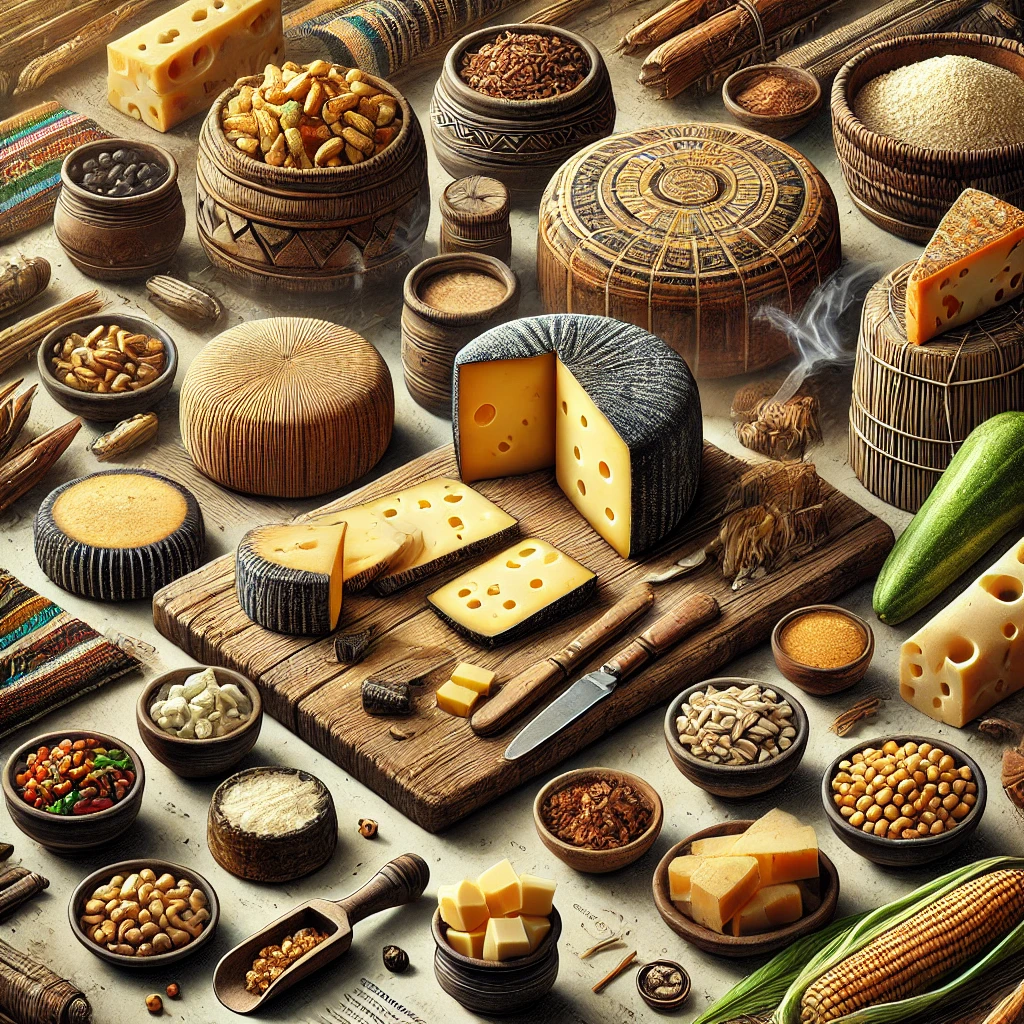The Republic of the Congo is best known for its forests, rivers, and rich culinary traditions rooted in agriculture, fishing, and pastoral life. While cheese is not as widely commercialized here as in Europe, traditional smoked cheeses hold an important place in rural communities, especially where refrigeration is limited.
Smoking cheese in the Congo is not about luxury or long aging. It is a practical preservation technique that enhances flavor, extends shelf life, and fits naturally into Central African cooking. These smoked cheeses are deeply connected to daily life, seasonal milk production, and ancestral knowledge passed down through generations.
Historical Background of Smoked Cheese in the Congo
Cheese-making in the Republic of the Congo developed independently from European traditions. Long before modern refrigeration, Congolese communities relied on smoking, drying, and fermenting to preserve food.
Milk from cows, goats, or sheep was quickly transformed into curds. Smoking the cheese over wood fires served several purposes:
-
Reduced moisture
-
Added antimicrobial protection
-
Introduced smoky, savory flavor
Smoked cheese became especially important in forest and savanna regions, where food needed to last through travel, trade, or dry seasons.
Why Smoking Is Central to Congolese Cheese
Smoking is one of the most effective preservation methods in tropical climates.
Key Benefits of Smoking
-
Extends shelf life without refrigeration
-
Protects against insects and spoilage
-
Adds deep, earthy flavor
-
Strengthens the cheese’s outer surface
In Congolese cheese traditions, smoking is functional first, flavorful second, though the taste has become deeply appreciated over time.
Milk Sources Used in Smoked Cheeses
Traditional smoked cheeses in the Republic of the Congo are made using locally available milk.
Cow’s Milk
Most common in pastoral areas, producing mild, firm curds.
Goat’s Milk
Used in drier or forest-edge regions, adding tangy notes.
Mixed Milk
Sometimes combined depending on herd availability.
Milk is usually fresh and minimally processed before curdling.
Traditional Smoked Cheese Varieties in the Republic of the Congo
Unlike European cheeses, Congolese smoked cheeses are not standardized or formally named. Instead, they are best understood by style and preparation.
Smoked Fresh Curd Cheese
This is the most widespread form of smoked cheese.
Characteristics:
-
Lightly pressed curds
-
Short smoking time
-
Soft to semi-firm texture
-
Mild smoky aroma
Uses:
Eaten with cassava, plantains, or maize-based dishes.
Heavily Smoked Dried Cheese
Designed for longer storage, especially during travel.
Characteristics:
-
Firmer, drier texture
-
Intense smoky flavor
-
Darkened outer surface
Uses:
Grated or softened in soups and stews.
Smoked Fermented Cheese
Some communities allow curds to ferment slightly before smoking.
Characteristics:
-
Tangier flavor
-
Dense interior
-
Strong aroma
Uses:
Added to sauces or eaten in small portions.
Traditional Smoking Methods
Smoking is done using local hardwoods, which influence flavor.
Common Smoking Techniques
-
Cheese placed on raised racks
-
Slow smoking over smoldering wood
-
Several hours to multiple days of exposure
-
Natural air drying between smoking sessions
Woods such as acacia or forest hardwoods impart earthy, subtle bitterness.
Texture and Appearance
| Cheese Style | Texture | Appearance |
|---|---|---|
| Lightly Smoked | Soft to semi-firm | Pale interior, light brown surface |
| Heavily Smoked | Firm to hard | Dark exterior |
| Fermented Smoked | Dense | Uneven, rustic |
Irregular shapes reflect hand-formed production.
Taste Profile of Congolese Smoked Cheeses
Congolese smoked cheeses are bold yet simple.
Flavor Notes
-
Pronounced smokiness
-
Mild dairy sweetness
-
Earthy, woody undertones
-
Light tang or saltiness
Flavor intensity increases with smoking duration and fermentation.
Role in Traditional Congolese Cuisine
Smoked cheese is rarely eaten alone. It is an ingredient that adds depth.
Traditional Culinary Uses
-
Crumbled into cassava leaves
-
Added to vegetable stews
-
Paired with boiled yams or plantains
-
Eaten with flatbreads
It provides protein and flavor to otherwise plant-based meals.
Modern and Contemporary Uses
As interest in African food heritage grows, Congolese smoked cheese is gaining recognition.
Modern Applications
-
Farm-to-table African cuisine
-
Fusion dishes
-
Specialty markets
-
Cultural food festivals
Chefs value its intense aroma and authenticity.
Best Food Pairings
Traditional Pairings
-
Cassava (fufu or chikwangue)
-
Plantains
-
Maize porridge
Modern Pairings
-
Roasted vegetables
-
Flatbreads
-
Grilled meats
The cheese pairs best with neutral or starchy foods.
Beverage Pairings
Traditional beverages complement smoked flavors.
Beverage Options
-
Palm wine
-
Herbal teas
-
Light beer
-
Fresh water
Smokiness pairs well with lightly acidic drinks.
Nutritional Value
Smoked cheeses offer important nourishment.
Nutritional highlights:
-
Protein for muscle and energy
-
Calcium for bone health
-
Natural fats
-
Extended usability without preservatives
Because they are filling, small amounts are typically consumed.
Smoked Cheese vs Fresh Cheese in the Congo
| Feature | Smoked Cheese | Fresh Cheese |
|---|---|---|
| Shelf life | Longer | Very short |
| Flavor | Smoky, bold | Mild |
| Use | Cooking | Immediate eating |
| Preservation | Natural | None |
Smoking transforms cheese into a practical survival food.
Buying and Storing Traditional Smoked Cheese
Buying Tips
-
Purchase from trusted local producers
-
Look for clean smoke aroma
-
Avoid mold not intended by tradition
Storage Tips
-
Keep dry and ventilated
-
Refrigerate if possible
-
Re-smoke lightly if moisture returns
Traditional knowledge guides storage practices.
Cultural Importance Today
Traditional smoked cheese remains a symbol of self-reliance and heritage in the Republic of the Congo. It reflects how communities adapt food traditions to environment, climate, and daily needs.
As global interest in indigenous foods increases, these cheeses offer valuable insight into Central African culinary resilience.
Conclusion
Traditional smoked cheese varieties of the Republic of the Congo are not defined by branding or standardization, but by function, flavor, and cultural memory. Shaped by fire, smoke, and necessity, these cheeses represent a living tradition that continues to nourish families and preserve identity.
Exploring Congolese smoked cheese is about more than taste—it is about understanding how food, culture, and environment are deeply connected. These humble cheeses deserve recognition as an essential part of Africa’s diverse dairy heritage.
Frequently Asked Questions (FAQ)
What milk is used for smoked cheese in the Republic of the Congo?
Cow’s milk is most common, with goat or mixed milk also used.
Are Congolese smoked cheeses aged?
They are smoked and sometimes lightly dried, but not aged like European cheeses.
How do smoked cheeses taste?
They have strong smoky flavor with mild dairy notes and earthy undertones.
How are these cheeses traditionally eaten?
They are added to stews, eaten with cassava or plantains, or used as flavoring.
Are Congolese smoked cheeses widely available internationally?
No, they are mostly local and rarely exported, making them culturally significant regional foods.



